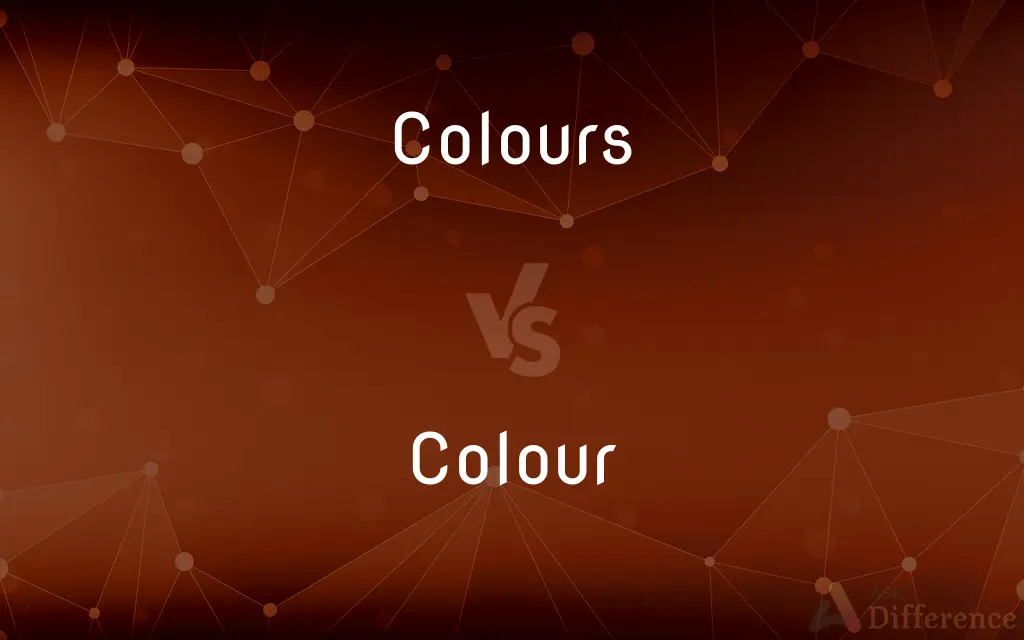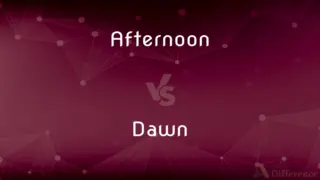Colours vs. Colour — What's the Difference?
By Tayyaba Rehman & Maham Liaqat — Updated on April 8, 2024
Colours refer to the spectrum of hues seen by the human eye, encompassing a wide range, while colour is a singular term referring to any specific hue within that spectrum.

Difference Between Colours and Colour
Table of Contents
ADVERTISEMENT
Key Differences
Colours encompass the entire spectrum visible to the human eye, including red, blue, yellow, and more. This term signifies variety and diversity in hues. On the other hand, colour refers to a specific hue or tint, such as red or blue, highlighting a singular aspect of the spectrum.
While colours can represent a myriad of hues, indicating diversity and a wide range of options, colour focuses on an individual hue's properties, such as its wavelength or how it is perceived by the human eye. Whereas colours might be discussed in the context of preferences, fashion, or design, highlighting choices and variety, colour might be analyzed for its psychological impact, its role in art, or its significance in symbolism.
In the realm of art and design, colours play a crucial role in composition and aesthetics, offering artists and designers a palette to convey messages, evoke emotions, or create visual interest. In contrast, the study of a single colour can delve into its cultural meanings, its use in specific art pieces, or its psychological effects on viewers.
When talking about personal preferences, people often discuss their favourite colours, indicating the plural form's role in expressing individual tastes among the wide array available. Meanwhile, discussing a colour in isolation might involve its specific associations, such as red with love or danger, showcasing how singular colours carry distinct meanings.
In terms of perception, colours collectively refer to the variety we can distinguish in the world around us, from the myriad shades in a sunset to the vast array of colours in a garden. Colour, used singularly, can denote the specific perception of one hue, influenced by factors like lighting, context, and cultural background, emphasizing the individual experience of seeing a particular hue.
ADVERTISEMENT
Comparison Chart
Definition
Refers to the entire range of hues visible to the human eye.
Refers to a specific hue within the spectrum.
Context of Use
Used when discussing variety, diversity, or a range of options.
Used when focusing on the properties or associations of a single hue.
Role in Art and Design
Signifies the use of multiple hues for aesthetic, emotional, or symbolic purposes.
Focuses on the impact or meaning of a singular hue in a composition.
Personal Preferences
Often discussed in plural to express favorites or choices among many options.
Discussed in singular to specify one's particular preference or the significance of one hue.
Perception and Meaning
Emphasizes the collective ability to distinguish various hues.
Highlights the individual experience and cultural significance of seeing a specific hue.
Compare with Definitions
Colours
Colours can dramatically affect the mood and atmosphere of any space.
Choosing the right colours for a room can enhance its appeal.
Colour
Colour refers to any single hue identified by specific characteristics.
The colour blue is calming and is often associated with serenity.
Colours
Colours refer to the entire spectrum of hues that can be seen by the human eye.
The artist uses vibrant colours to bring her paintings to life.
Colour
Colour can significantly impact design and aesthetic choices.
Using a splash of colour can make an artwork pop.
Colours
The term encompasses all possible tints, shades, and tones available.
The fashion designer is known for her bold use of colours.
Colour
It is a specific portion of the spectrum, distinct from others.
The colour green is said to represent growth and renewal.
Colours
Colours play a significant role in symbolism and cultural significance.
In many cultures, colours are used to represent various holidays and traditions.
Colour
Individual colour preferences can say a lot about a person.
His favourite colour is red, which suits his energetic personality.
Colours
People often have personal preferences for certain colours.
My friend loves bright colours; they're all over her wardrobe.
Colour
The cultural meanings of a colour can vary widely.
In some cultures, the colour white is worn at weddings, while in others, it's worn at funerals.
Colours
Variant of color.
Colour
The property possessed by an object of producing different sensations on the eye as a result of the way it reflects or emits light
The lights flickered and changed colour
Colours
Plural of colour
Colour
Pigmentation of the skin, especially as an indication of someone's race
Discrimination on the basis of colour
Colours
(nautical) Flag denoting the nationality of a vessel, flown from the stern.
Colour
Vivid appearance resulting from the juxtaposition of many bright things
For colour, plant groups of winter-flowering pansies
Colours
Same as colors.
Colour
An item or items of a particular colour worn to identify or distinguish an individual or a member of a group, in particular a jockey or a member of a sports team
It was Devon Loch's first victory in the colours of his royal owner
It will be strange running on to the pitch in another team's colours
Colours
A distinguishing emblem;
His tie proclaimed his school colors
Colour
A shade of meaning
Many events in her past had taken on a different colour
Colours
A flag that shows its nationality
Colour
A quantized property of quarks which can take three values (designated blue, green, and red) for each flavour.
Colour
Change the colour of (something) by painting, dyeing, or shading it
He coloured her hair with a selection of blonde and brown shades
Colour
(of a person or their skin) show embarrassment or shame by becoming red; blush
She coloured slightly
Colour
Influence, especially in a negative way; distort
The experiences had coloured her whole existence
Colour
Variant of color.
Colour
Standard spelling of from2=Canada
Colour
Standard spelling of from2=Canada
Colour
Standard spelling of from2=Canada
Colour
See Color.
Colour
Any material used for its color;
She used a different color for the trim
Colour
A race with skin pigmentation different from the white race (especially Blacks)
Colour
(physics) the characteristic of quarks that determines their role in the strong interaction; each flavor of quarks comes in three colors
Colour
Interest and variety and intensity;
The Puritan Period was lacking in color
Colour
The timbre of a musical sound;
The recording fails to capture the true color of the original music
Colour
A visual attribute of things that results from the light they emit or transmit or reflect;
A white color is made up of many different wavelengths of light
Colour
An outward or token appearance or form that is deliberately misleading;
He hoped his claims would have a semblance of authenticity
He tried to give his falsehood the gloss of moral sanction
The situation soon took on a different color
Colour
The appearance of objects (or light sources) described in terms of a person's perception of their hue and lightness (or brightness) and saturation
Colour
Modify or bias;
His political ideas color his lectures
Colour
Decorate with colors;
Color the walls with paint in warm tones
Colour
Gloss or excuse;
Color a lie
Colour
Affect as in thought or feeling;
My personal feelings color my judgment in this case
The sadness tinged his life
Colour
Add color to;
The child colored the drawings
Fall colored the trees
Colorize black and white film
Colour
Change color, often in an undesired manner;
The shirts discolored
Colour
Having or capable of producing colors;
Color film
He rented a color television
Marvelous color illustrations
Common Curiosities
Can the colour of a room affect your mood?
Yes, the colour of a room can influence one's mood and feelings, with different colours having various effects.
What does colours mean?
Colours refer to the full range of hues visible to the human eye.
How do colours affect mood?
Colours can evoke different emotions and feelings, depending on their hue, saturation, and brightness.
Can everyone see all colours?
Differences in perception, such as colour blindness, mean not everyone sees colours the same way.
Why is colour important in design?
Colour is vital in design for attracting attention, creating harmony, and communicating messages effectively.
What does colour mean?
Colour refers to any specific hue or shade within the visible spectrum.
Why do artists use a variety of colours?
Artists use colours to express emotions, create depth, and convey messages or themes in their work.
How do personal preferences for colours develop?
Preferences for colours can develop from personal experiences, cultural influences, and individual personality traits.
Why are colours important in branding?
Colours are crucial in branding because they can convey specific messages, evoke emotions, and influence consumer behavior.
Is there a universal meaning for colours?
While some colour associations are common, meanings can vary significantly across different cultures and individuals.
How do colours influence fashion?
Colours significantly influence fashion by determining trends, expressing moods or seasons, and allowing for personal expression.
How do colours and colour differ in art?
While colours refer to the use of multiple hues in art, colour focuses on the properties and impact of a specific hue.
Can the same colour have different meanings?
Yes, the same colour can have different meanings in various contexts or cultures.
How do colours enhance the learning environment?
Colours can enhance learning by improving mood, increasing attention, and facilitating memory retention.
What is the psychological impact of colour?
Colour psychology studies how hues can influence human behavior, including mood, perceptions, and actions.
Share Your Discovery

Previous Comparison
Afternoon vs. Dawn
Next Comparison
Hound vs. TerrierAuthor Spotlight
Written by
Tayyaba RehmanTayyaba Rehman is a distinguished writer, currently serving as a primary contributor to askdifference.com. As a researcher in semantics and etymology, Tayyaba's passion for the complexity of languages and their distinctions has found a perfect home on the platform. Tayyaba delves into the intricacies of language, distinguishing between commonly confused words and phrases, thereby providing clarity for readers worldwide.
Co-written by
Maham Liaqat















































